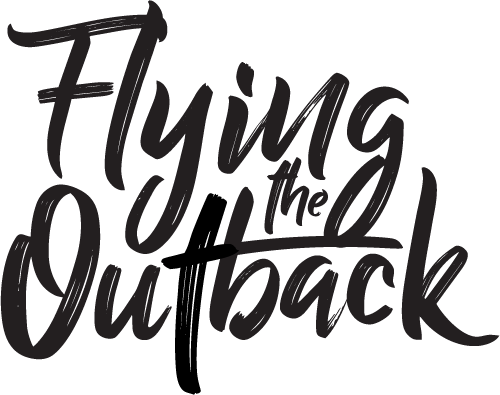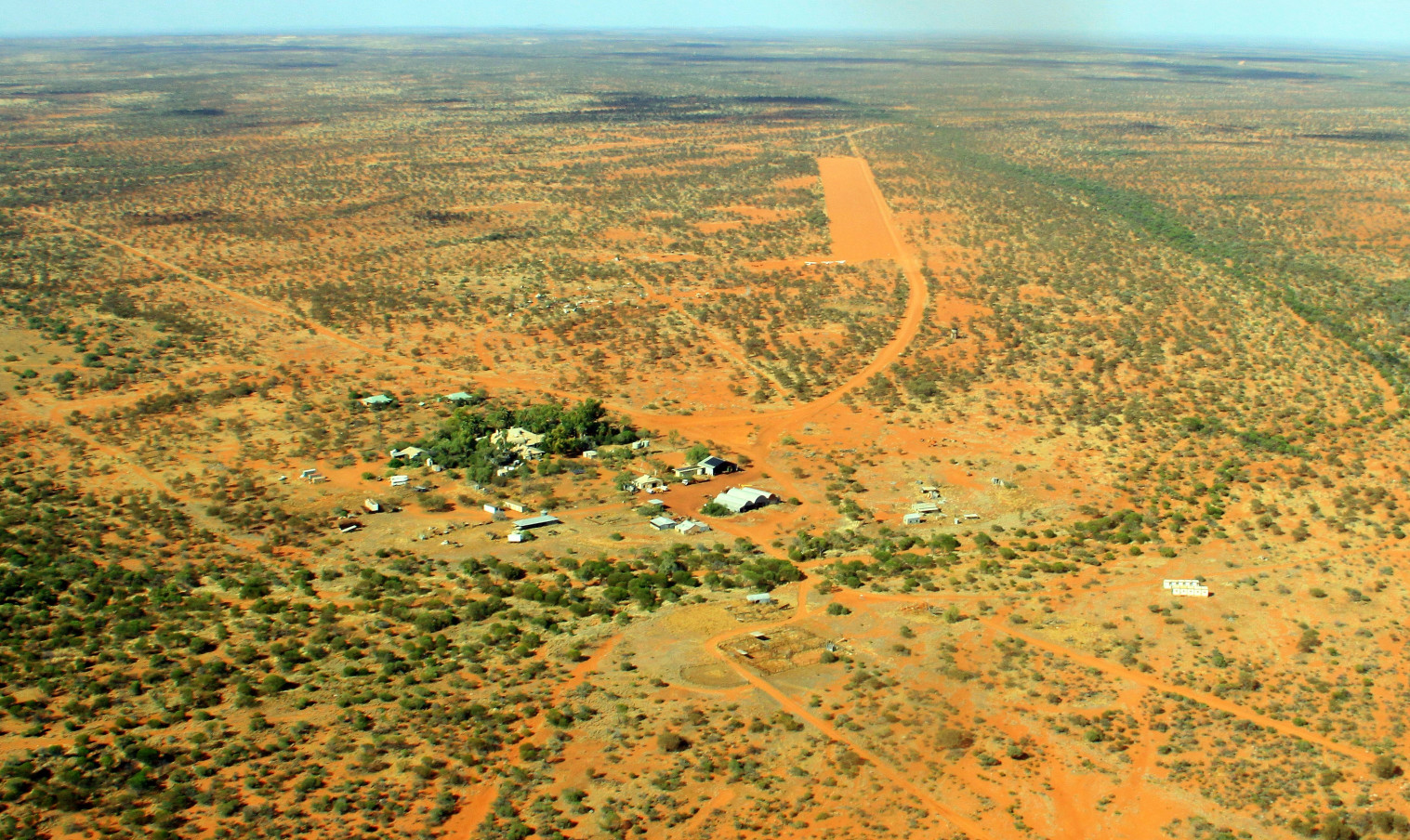This is saltbush and bluebush country. It might not look too appetising to us, but sheep and cattle think it’s delicious. Hold that thought as we unroll the epic story that defines today’s Wooleen Station.
Wooleen is a big old sprawling property in the far west Murchison region of Western Australia, covering more than a quarter of a million acres of once prime agricultural land. To ease the impossibly high financial pressure of running the property, the current managers have opened their gates to tourism. It wasn’t much of a diversion for us to pass their gate, so we figured it a really good idea to call in and say hello.
A smooth introduction
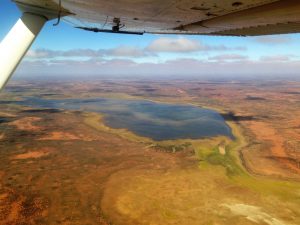 David and Frances Pollock are your hosts at Wooleen Station. Our group of eight has flown four Cessnas in for a two-night stay, mid-way through a three-week air safari from the east coast. It’s winter, but WA didn’t get the memo. We’d just spent four days beach-combing on Dirk Hartog Island, just south of Carnarvon, and home to the most westerly point on the Australian map. Now turning eastwards on the home run, we’re all greatly looking forward to joining the circuit at the magnificent big red airstrip that awaited us at Wooleen.
David and Frances Pollock are your hosts at Wooleen Station. Our group of eight has flown four Cessnas in for a two-night stay, mid-way through a three-week air safari from the east coast. It’s winter, but WA didn’t get the memo. We’d just spent four days beach-combing on Dirk Hartog Island, just south of Carnarvon, and home to the most westerly point on the Australian map. Now turning eastwards on the home run, we’re all greatly looking forward to joining the circuit at the magnificent big red airstrip that awaited us at Wooleen.
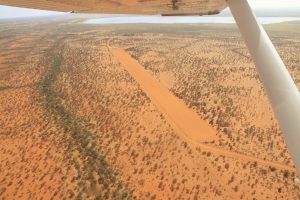 And magnificent it is. I had rung and spoken to Frances about their strip, and she had offered us a choice of two. They have an 1800m airstrip used by the RFDS, a mile or so from the homestead, but we were more than welcome to use the shorter strip at the homestead if we wished. She assured me it was maintained to the same high standard and, at a length of almost 1000m and of generous width, this was an understatement. Its perfectly flat and meticulously rolled surface stands out for miles, and it indeed proves to be a beautiful welcome mat, sure to keep the fussiest urban pilot happy. Even a Cirrus owner.
And magnificent it is. I had rung and spoken to Frances about their strip, and she had offered us a choice of two. They have an 1800m airstrip used by the RFDS, a mile or so from the homestead, but we were more than welcome to use the shorter strip at the homestead if we wished. She assured me it was maintained to the same high standard and, at a length of almost 1000m and of generous width, this was an understatement. Its perfectly flat and meticulously rolled surface stands out for miles, and it indeed proves to be a beautiful welcome mat, sure to keep the fussiest urban pilot happy. Even a Cirrus owner.
Soaked in history
To come away with a feel for what David and Frances are attempting to accomplish at Wooleen, you need to absorb a little of its history. Like many people, we had seen Wooleen featured on the ABC’s Australian Story in 2012 and again in 2014. Theirs is not an easy story to forget.
 It seems that, in the decades leading up to the 1930s, the government of the time encouraged graziers to carry maximum numbers of stock. “Wool for the masses!” it cried. “Wool is the future!” Australia was running more sheep than any other country in the world, and times were good for the pastoralists. Grand old dwellings like the now National Trust-listed Wooleen Homestead were not uncommon through the outback.
It seems that, in the decades leading up to the 1930s, the government of the time encouraged graziers to carry maximum numbers of stock. “Wool for the masses!” it cried. “Wool is the future!” Australia was running more sheep than any other country in the world, and times were good for the pastoralists. Grand old dwellings like the now National Trust-listed Wooleen Homestead were not uncommon through the outback.
Then came the 1930s.
The big drought started in 1931. Pastoralists out here know a lot about that drought after a 1941 Royal Commission assessed the loss of economic potential of the land. The Commission estimated that 75 percent of the palatable perennial species in this part of the country had been wiped out. Even 25 percent of the acacias, which are usually way down the menu highlights for the sheep, were wiped out.
Wooleen went into the drought with 26,000 sheep and came out with 10,000. So 16 thousand sheep died of starvation. They had plenty of water from what was being pumped up by the windmills, but there was just no feed. Fading and crackled photos from that time show the country as a barren dust bowl, devoid even of a single stick on the ground. The stock had eaten absolutely everything.
“It’s pretty hard to starve a sheep,” explains David Pollock, as our vehicle bumps its way along the rough and twisting track. “But even so, the drought got a great many of them. And it wasn’t just around here, it spread across the entire area from just east of the Nullarbor, all the way through to around Exmouth – an area about the size of NSW and Tasmania combined.”
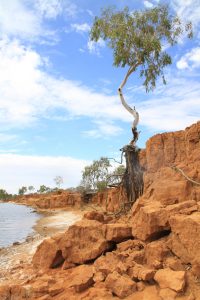 As a result of the drought, the Murchison rangelands where Wooleen lies lost its entire covering of vegetation – saltbushes and bluebushes whose roots were holding the soil together. Without them, the area was now completely susceptible to wind erosion, which reduced the once productive country to bare ground and rocks, much of which, 80 years later, looks little different.
As a result of the drought, the Murchison rangelands where Wooleen lies lost its entire covering of vegetation – saltbushes and bluebushes whose roots were holding the soil together. Without them, the area was now completely susceptible to wind erosion, which reduced the once productive country to bare ground and rocks, much of which, 80 years later, looks little different.
Unfortunately, stock numbers were reintroduced after the drought, giving the desecrated land an almost zero chance of regenerating itself. The reality is, the region never recovered. Subsequent years saw further droughts and consistent grazing slowly diminishing any hopes of a sustainable agricultural future out here.
And in a cruel display of what mother nature is capable of, major floods in 2006 and 2011 saw to it that what little soil remained washed away across the landscape with no established vegetation to curb its determined path.
Sharing the vision
From the moment we jump into the Wooleen bus where David has picked us up from the airstrip, we are enveloped in this saga that is as big as the land is ancient. We are warmly welcomed into their beautiful 100-year-old homestead, where seven ultra-comfortable guest rooms occupy a dedicated wing of the house, surrounded by colonial verandas and a magnificent drought-savvy garden.
 On an afternoon tour of the station, David shares with us his mission to find a sustainable way of eventually running stock on his pastures while still looking after the environment. A mission requiring the patience of Job. With the degradation of the land being the unmistakable result of past years of over-grazing on land that was simply not up to the task, he had made the difficult decision to completely destock Wooleen when he took over in 2007.
On an afternoon tour of the station, David shares with us his mission to find a sustainable way of eventually running stock on his pastures while still looking after the environment. A mission requiring the patience of Job. With the degradation of the land being the unmistakable result of past years of over-grazing on land that was simply not up to the task, he had made the difficult decision to completely destock Wooleen when he took over in 2007.
A qualified and passionate environmental conservationist, David added more than a little faith to the mix when he did this, undertaking what was considered a highly controversial and counter-cultural move in the eyes of the surrounding graziers. Not to mention financially crippling. “A few years ago, we couldn’t even afford to buy our groceries,” says David.
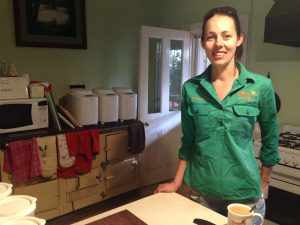 Which is why the tourism side of Wooleen is so vitally important. When she walked onto Wooleen and into David’s life in 2008, Frances threw herself into David’s quest to save the land he loved so much. And there’s no doubt he is making inroads, with encouraging results from the regenerative programs he has introduced on Wooleen. Meanwhile, with a degree in eco-tourism and highly developed skills in customer service, Frances set about promoting Wooleen as a more than memorable station-stay for visitors. Her plan was to literally bring tourists to the table by offering them a uniquely personal experience in their home, while being offered a rare glimpse into daily life on a working station.
Which is why the tourism side of Wooleen is so vitally important. When she walked onto Wooleen and into David’s life in 2008, Frances threw herself into David’s quest to save the land he loved so much. And there’s no doubt he is making inroads, with encouraging results from the regenerative programs he has introduced on Wooleen. Meanwhile, with a degree in eco-tourism and highly developed skills in customer service, Frances set about promoting Wooleen as a more than memorable station-stay for visitors. Her plan was to literally bring tourists to the table by offering them a uniquely personal experience in their home, while being offered a rare glimpse into daily life on a working station.
All in a day’s work
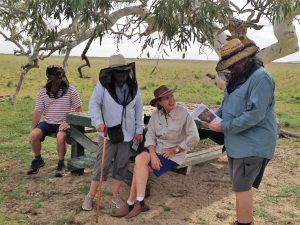 There is plenty to keep you occupied during your stay on Wooleen. We take advantage of cool temps on our first morning here to set off on Walk Trail No 1. With hats, sunscreen, fly nets and white posts to guide us, we set off by ourselves and take a crash course in the fascinating biology of these Mulga shrub lands on which Wooleen sits. Frances has compiled our info-packed booklets, which marry the habits of the resident bird and wildlife with the history and remains of a once massive shearing operation.
There is plenty to keep you occupied during your stay on Wooleen. We take advantage of cool temps on our first morning here to set off on Walk Trail No 1. With hats, sunscreen, fly nets and white posts to guide us, we set off by ourselves and take a crash course in the fascinating biology of these Mulga shrub lands on which Wooleen sits. Frances has compiled our info-packed booklets, which marry the habits of the resident bird and wildlife with the history and remains of a once massive shearing operation.
Back in Frances’ big open kitchen at lunchtime, I look alarmingly at the three bread-makers sitting on her bench. Everything out here needs to be big, I’ve decided. Everything happens in bulk. Our whole group is talking at once, so I find I only ask her a quarter of the million probing questions I have about this oh-so-different life she’s chosen, starting with where she retrieves her boundless energy every day. Then I remember she’s still sitting on the bubbly side of 30 – an unlikely matriarch in anyone’s language – but with her warm and engaging personality, it’s as if Frances has been born for this role. She’s already whipped up a few loaves this morning, made our breakfast, had a chat with the postman while he tumbled out their pile of mail onto the table, and is no doubt about to dive into her office before sorting out dinner for 10 in the formal dining room tonight.
That illusive commodity of water
 Back on our station tour, we stop again near the edge of Wooleen Lake, listed as a nationally important wetland for its attraction to thousands of bird species when nesting. “Normally, this is dry,” says David. “You’re quite lucky to see it with this much water in it. It gets enough water to fill the bottom about one year in four. Then one year in nine it fills up. We’ll generally lose two metres a year in evaporation though, so once it’s full, it takes about a year to dry up again.
Back on our station tour, we stop again near the edge of Wooleen Lake, listed as a nationally important wetland for its attraction to thousands of bird species when nesting. “Normally, this is dry,” says David. “You’re quite lucky to see it with this much water in it. It gets enough water to fill the bottom about one year in four. Then one year in nine it fills up. We’ll generally lose two metres a year in evaporation though, so once it’s full, it takes about a year to dry up again.
“And then on average about every 30 years it gets over-full. It fills from the Roderick River then flows up into the Murchison River, but if the Murchison is high, it’ll flow back into here. So every 30 years it backs up, and flows over all these gates here, so that’s pretty exciting.” David gives the story the typically understated mark of a seasoned farmer, and we’re left in no doubt that the floods of 2006 and 2011 made life at Wooleen a little bit more than ‘pretty exciting’.
We hear how the area is now getting hit with bigger floods more often, largely because of the degraded landscape, allowing all the water to rush off the surface too quickly. When it’s around, the fresh water in the lake is useful in helping to grow the vital perennial grass which cattle love to eat. This is the essence of David’s mission, to nurture the land over time and provide perennial and palatable feed for future restocking of Wooleen.
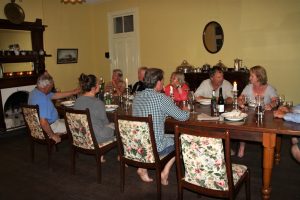 Over a gorgeous dinner with our hosts that evening, the discussion roams from the aboriginal heritage of the area, to the predatory habits of dingos, to the challenge of goats and roos who don’t respect conventional fences, to how a bunch of people found themselves flying into a remote airstrip so far from home.
Over a gorgeous dinner with our hosts that evening, the discussion roams from the aboriginal heritage of the area, to the predatory habits of dingos, to the challenge of goats and roos who don’t respect conventional fences, to how a bunch of people found themselves flying into a remote airstrip so far from home.
Worthy inclusion
Wooleen is a fair distance away for we east-coasters, so it’s not going to be on our long weekender list. But what’s the point of a pilot’s licence if we don’t give it a good run? I unreservedly recommend you try and slot this property into a WA itinerary. When you think about it, it’s positively in the neighbourhood with drop-dead gorgeous drawcards like swimming with the whale sharks on Ningaloo Reef (land at Coral Bay or Exmouth), dropping in on the Pilbara’s incredible Karijini National Park (Karijini airstrip at your service), overflying the beautiful Abrolhos Islands near Geraldton and delving even deeper into the remote outback with a visit to the historical northern goldfields of WA. We found fuel and secure parking at Leonora. And don’t forget Dirk Hartog Island, that I told you about last year. Land on the island or leave your plane at Shark Bay and get a lift over on their fishing boat. Come on, get onto it.
Rossy and I want to go back to Wooleen. For me, the golden difference compared with some other station stays was the time that our hosts made available to spend with us. Sure, they want to share their story, and try to help visitors understand landscape rehabilitation, but they’re also wildly keen to hear our opinions and views as well, and the exchange of conversation around this grand old dining table offers a tangible connection between town and country.
David and Frances are astute operators, and their seemingly effortless knack of feeding, educating and entertaining a houseful of visitors while a quarter of a million acres is panting for their attention outside, is not lost on any of us. What a pleasure it was to be welcomed into their home.
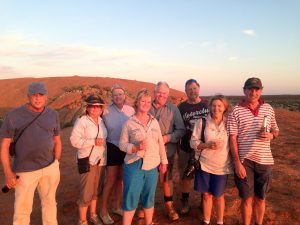 On our final night, as we approach one of Wooleen’s magnificent red rock granite outcrops for sunset drinks, David slows the vehicle and pulls up beside a nondescript clump of saltbush plants. “Once these little bushes get going,” he yells to no-one in particular, “more of them will grow and we’ll come back in five years and lots more will have grown. I will have reinstated the function of this patch of land and I’ll be happy with that.”
On our final night, as we approach one of Wooleen’s magnificent red rock granite outcrops for sunset drinks, David slows the vehicle and pulls up beside a nondescript clump of saltbush plants. “Once these little bushes get going,” he yells to no-one in particular, “more of them will grow and we’ll come back in five years and lots more will have grown. I will have reinstated the function of this patch of land and I’ll be happy with that.”
More info: www.wooleen.com.au
